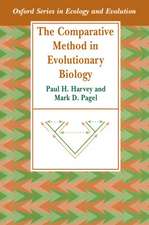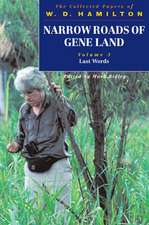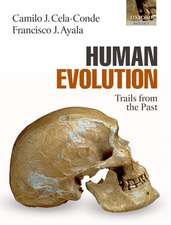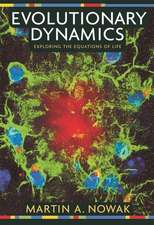Evolution in Action: Case studies in Adaptive Radiation, Speciation and the Origin of Biodiversity
Editat de Matthias Glaubrechten Limba Engleză Paperback – 11 oct 2014
| Toate formatele și edițiile | Preț | Express |
|---|---|---|
| Paperback (1) | 1231.78 lei 6-8 săpt. | |
| Springer Berlin, Heidelberg – 11 oct 2014 | 1231.78 lei 6-8 săpt. | |
| Hardback (1) | 1236.99 lei 6-8 săpt. | |
| Springer Berlin, Heidelberg – 3 aug 2010 | 1236.99 lei 6-8 săpt. |
Preț: 1231.78 lei
Preț vechi: 1502.17 lei
-18% Nou
Puncte Express: 1848
Preț estimativ în valută:
235.69€ • 246.09$ • 195.07£
235.69€ • 246.09$ • 195.07£
Carte tipărită la comandă
Livrare economică 04-18 aprilie
Preluare comenzi: 021 569.72.76
Specificații
ISBN-13: 9783642423734
ISBN-10: 3642423736
Pagini: 612
Ilustrații: XXV, 586 p.
Dimensiuni: 155 x 235 x 32 mm
Greutate: 0.85 kg
Ediția:2010
Editura: Springer Berlin, Heidelberg
Colecția Springer
Locul publicării:Berlin, Heidelberg, Germany
ISBN-10: 3642423736
Pagini: 612
Ilustrații: XXV, 586 p.
Dimensiuni: 155 x 235 x 32 mm
Greutate: 0.85 kg
Ediția:2010
Editura: Springer Berlin, Heidelberg
Colecția Springer
Locul publicării:Berlin, Heidelberg, Germany
Public țintă
ResearchDescriere
Radiations, or Evolution in Action We have just celebrated the “Darwin Year” with the double anniversary of his 200th birthday and 150th year of his masterpiece, “On the Origin of Species by means of Natural Selection”. In this work, Darwin established the factual evidence of biological evolution, that species change over time, and that new organisms arise by the splitting of ancestral forms into two or more descendant species. However, above all, Darwin provided the mechanisms by arguing convincingly that it is by natural selection – as well as by sexual selection (as he later added) – that organisms adapt to their environment. The many discoveries since then have essentially con?rmed and strengthened Darwin’s central theses, with latest evidence, for example, from molecular genetics, revealing the evolutionary relationships of all life forms through one shared history of descent from a common ancestor. We have also come a long way to progressively understand more on how new species actually originate, i. e. on speciation which remained Darwin’s “mystery of m- teries”, as noted in one of his earliest transmutation notebooks. Since speciation is the underlying mechanism for radiations, it is the ultimate causation for the biological diversity of life that surrounds us.
Cuprins
Approaches in Botany.- Rapid Radiations and Neoendemism in the Madagascan Biodiversity Hotspot.- Rapid Radiation in the Barley Genus Hordeum (Poaceae) During the Pleistocene in the Americas.- Studying Adaptive Radiation at the Molecular Level: A Case Study in the Macaronesian Crassulaceae-Sempervivoideae.- Key Innovations Versus Key Opportunities: Identifying Causes of Rapid Radiations in Derived Ferns.- Evolution of the Mating System in the Genus Capsella (Brassicaceae).- Pollinator-Driven Speciation in Sexually Deceptive Orchids of the Genus Ophrys.- Population Genetics of Speciation and Demographic Inference Under Population Subdivision: Insights from Studies on Wild Tomatoes (Solanum sect. Lycopersicon).- Genetic Diversity, Evolution and Domestication of Wheat and Barley in the Fertile Crescent.- Host-Plant Interaction.- Mechanisms of Speciation in Southeast Asian Ant-Plants of the Genus Macaranga (Euphorbiaceae).- Speciation in Obligately Plant-Associated Crematogaster Ants: Host Distribution Rather than Adaption Towards Specific Hosts Drives the Process.- Radiation, Biological Diversity and Host–Parasite Interactions in Wild Roses, Rust Fungi and Insects.- Speciation via Differential Host–Plant Use in the Tephritid Fly Tephritis conura.- Approaches in Zoology.- Solar Powered Seaslugs (Opisthobranchia, Gastropoda, Mollusca): Incorporation of Photosynthetic Units: A Key Character Enhancing Radiation?.- Are Cuticular Hydrocarbons Involved in Speciation of Fungus-Growing Termites (Isoptera: Macrotermitinae)?.- Electric Organ Discharge Divergence Promotes Ecological Speciation in Sympatrically Occurring African Weakly Electric Fish (Campylomormyrus).- Ongoing Phenotypic and Genotypic Diversification in Adaptively Radiated Freshwater Crabs from Jamaica.- The Herring Gull Complex (Larus argentatus - fuscus - cachinnans) as a Model Group for Recent Holarctic Vertebrate Radiations.- Genetic Divergence and Evolution of Reproductive Isolation in Eastern Mediterranean Water Frogs.- Inferring Multiple Corsican Limax (Pulmonata: Limacidae) Radiations: A Combined Approach Using Morphology and Molecules.- Palaeogeography or Sexual Selection: Which Factors Promoted Cretan Land Snail Radiations?.- Non-Ecological Radiations in Acoustically Communicating Grasshoppers?.- Beyond Sympatric Speciation: Radiation of Sailfin Silverside Fishes in the Malili Lakes (Sulawesi).- The Species Flocks of the Viviparous Freshwater Gastropod Tylomelania (Mollusca: Cerithioidea: Pachychilidae) in the Ancient Lakes of Sulawesi, Indonesia: The Role of Geography, Trophic Morphology and Color as Driving Forces in Adaptive Radiation.- Speciation and Radiation in a River: Assessing the Morphological and Genetic Differentiation in a Species Flock of Viviparous Gastropods (Cerithioidea: Pachychilidae).- The Neglected Side of the Coin: Non-adaptive Radiations in Spring Snails (Bythinella spp.).
Textul de pe ultima copertă
We have come a long way towards better understanding how new species originate, i.e. speciation, which long remained Darwin’s “mystery of mysteries.” Since speciation is the underlying mechanism for radiations, it is the ultimate causation for the biological diversity of life that surrounds us. Without a doubt, Charles Darwin’s contribution to our understanding of the origin of biodiversity cannot be overestimated. This book is a contribution to both the Darwin Year we celebrated in 2009 and to the Year of Biodiversity and Conservation 2010. The studies and model cases presented show the progress and dynamics of research based on Darwinian theories and sheds light on its implications in the context of current biodiversity crises. The great importance of adaptive (and non-adaptive) radiations for biodiversity is widely accepted, but our understanding of the processes and mechanisms involved is still limited and generalizations need to be based on the accumulation of more evidence from additional case studies. The studies presented in this volume are those urgently needed and focus on a variety of organisms and different aspects of radiations. The scientific results presented therein are excellent examples not only of evolution in action, but also of active research on evolutionary processes and their most apparent outcome – biodiversity.
Caracteristici
Reveals many aspects among the wide spectrum of current approaches in evolutionary research
Presents a colourfully illustrated survey of current evolutionary biology research
Use of modern techniques from molecular biology, bioinformatics and systematic phylogeny
Allows the reconstruction of the relationships of organisms, the course of evolution and its underlying causations
Includes supplementary material: sn.pub/extras
Presents a colourfully illustrated survey of current evolutionary biology research
Use of modern techniques from molecular biology, bioinformatics and systematic phylogeny
Allows the reconstruction of the relationships of organisms, the course of evolution and its underlying causations
Includes supplementary material: sn.pub/extras
















